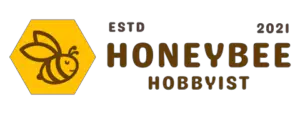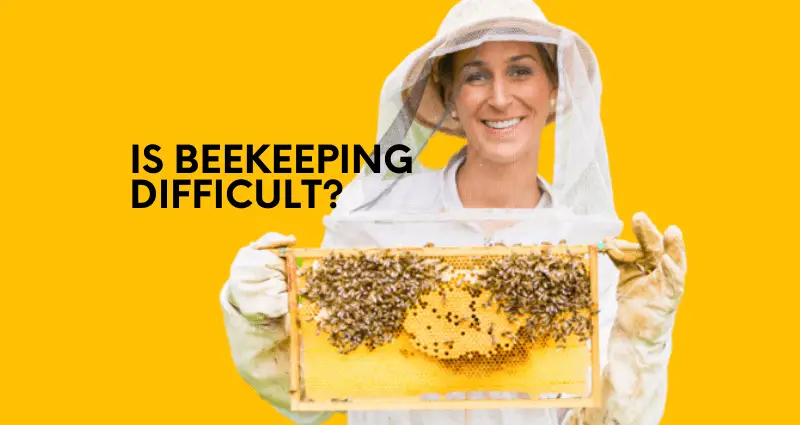Beekeeping is not difficult when compared to other hobbies or professions. Like all hobbies and aggricultural efforts, it poses challenges and has some costs involved. But beekeeping is a fascinating and rewarding hobby worth exploring.
Beekeeping is a very satisfying hobby that benefits the environment and supports the food chain as bees pollinate the plants our ecosystem relies on.
Honeybees also produce honey, honeycomb, and beeswax, which entrepreneurial beekeepers can sell for profit. Even beginner beekeepers can reap the benefits of maintaining bees as they watch these productive little creatures go about their work.
So, before we provide information about the costs, equipment, learning curve, and safety concerns, let’s run through a basic questionnaire to decide whether beekeeping is for you.
Please be critically honest when answering;
- Do you enjoy nature? Including following weather patterns, learning about local animal species, and being outside in hot or cold temperatures?
- Are you passionate about maintaining and growing bee populations to protect local and worldwide ecology? Including non-honeybee populations?
- Are you okay with investing money into maintaining your hives without the possibility of harvesting honey or earning cash from harvested honey?
- Like most rewarding hobbies, they can be time-consuming. Are you okay with investing significant amounts of time to support your colony’s needs?
- Are you allergic to honey, bee stings, pollen, beeswax, pests, or the plant life supporting a colony?
- Do you have physical limitations that might prevent you from carrying out colony care tasks, i.e., lifting 60+ pounds of equipment or hives?
- Are you committed to following your local and state apiary regulations?
- Have you corresponded with neighbors to make them aware of or receive approval of your beekeeping plans?
- Are you open to working with your local beekeepers and beekeeper associations?
If any of these questions raise concerns, please take ample time to address them before building your colony.
The Startup Costs Of Beekeeping
Beekeeping requires a number of upfront costs in your first year. From hives, habitat creation, protective clothing, miscellaneous supplies, and more…this can easily cost $1,000+ before bees are delivered and introduced to their new hive.
Backyard beekeepers also need to consider where they will place their hive(s), which need at least ¼ acre for 2 or more colonies in an area with plenty of plant life of pollination, water sources, and safety measures.
Click here to review our guide on bee habitats to ensure you have the necessary features to support bee colonies.
Equipment
Basic beekeeping equipment starts with selecting which type of beehive you’ll use. Most hives include brood boxes, supers for storing honey, frames, covers for various parts of the box, an entrance reducer, and sometimes hive stands.
Prices will vary by supplier, type of hive (for beginners, we recommend the Langstroth or top bar hive), and hive material, but some hive elements could also be produced on your own for much less money.
The popular beekeeping supply site Dadant lists a complete expanding aviary kit which includes two full-depth 9 5/8 inch brood boxes, two medium 6 5/8 inch depth honey supers, assembled frames w/ plasticell foundation, inner cover w/ telescoping cover, and an entrance reducer for runs $370.
Individual 10-frames boxes are $120.
Beekeepers also need a smoker ($50) that emits smoke to calm the bees by reducing the pheromones they emit when they sense danger.
Click here to learn more about bee smokers and how to use them.
You also need hive tools for opening the hive and removing hive frames, cutting honeycomb, cleaning the hives, and performing many tasks around the hive. While none of the tools are particularly expensive, the costs add up.
And finally, harvesting honey and processing your raw honey, will require additional tools and equipment. It’s quite possible that you will be processing pounds of honey each season, so you’ll want to be prepared for harvesting ahead of time.
Protective Clothing
Protective clothing is another expense that new beekeepers need to invest in. While honeybees may not attack unless they feel threatened, thousands of bees can be intimidating.
Bee suits with a hat and veil (attached or separate) as well as gloves are a must for anyone looking to tackle hive inspections and honey harvesting. Really anytime someone plans to get near a hive, a bee suit should be required.
Suits run around $100, hat and veil combinations about $25, and gloves $20 or more.
Other Essential Costs
Some vendors offer new hive packages that include many of the abovementioned items. These are great for your first hive and will run around $450 before you purchase a queen bee and a package of bees.
You might select packaged bee ($175 or a bee nuc ($200) that has been “overwintered” or survived the cost season for an extra $50.
Additional items may include, but are not limited to;
- Sugar for syrup and other food supplements
- Pollen patties
- Predator & Pesticide prevention
- Varroa Mite treatments
- Hive stands
- Watering stations
What is difficult to calculate is the increased costs for water, winterizing beehives, and any special equipment you might need, such as an electric fence.
Beekeeping is an art and a science that newbies learn by reading (here’s our list of the best beekeeping books), joining local beekeeping associations, seeking the help of experienced beekeepers, and taking classes to educate themselves. Training resources can add on another few hundred dollars.
Ongoing Beekeeping Costs
After the first season of beekeeping, a new hobbyist hopes to find the colony growing and the bees producing a good supply of honey. To expand the colony and prevent overcrowding, keepers eventually need to provide additional frames that the bees use to support their honeycomb of brood comb in the hive.
At a cost of a few hundred dollars, some owners will add a bee nuc that contains frames and drawn comb, honey, and brood to expand and strengthen the colony.
About a year after the hive, the bees amass a stock of honey that exceeds what they need to feed members of the hive, including new broods who develop in a part of the hive.
Beekeepers can extract the honey by first cutting out part of the comb with a knife or using a honey extractor. While honey extractors and related equipment such as tanks can cost thousands of dollars, prices for a basic manual extractor start at $100 on Amazon.
Even a keeper who continues to regard beekeeping as a hobby may need to buy new or additional tools, control pests, supplement the food supply, maintain and expand the hive, and occasionally purchase bees and/or a new queen.
Ongoing annual expenses for food and supplies run $80-100 per hive.
For a beekeeper who turns a hobby into a business, future needs include storage space, labeling equipment, and marketing expenditures to promote honey and beeswax sales.
The Learning Curve For Beekeeping
Beekeeping requires you to learn a lot about bees, from their anatomy, habits, habitats, lifecycle, and more. Not to mention weather, pests and predators, and a host of other facets of the hobby.
There is a steep learning curve with beekeeping but are plenty of resources available that wise hobbyists take advantage of. Many are online, but keepers will benefit from beekeeping classes and local groups.
Knowing about beekeeping may not prepare you for the hard work involved in setting up and maintaining clean, productive, healthy hives. Putting in the right balance of time, money, physical labor, and patience will pay off for anyone willing to devote the resources to this exciting hobby.
Avoiding Bee Stings
Not surprisingly, bee stings are an occupational hazard of beekeeping. Bee stings are uncomfortable but seldom fatal. An adult can sustain 1,000 bee stings; few beekeepers want to test the theory.
Dressing in your protective clothing and calming them with a smoker will reduce the threat and number of stings. Honey bees don’t randomly attack people but will do so if angry.
Some people are highly allergic to bee stings and may suffer an anaphylactic shock if they are stung. An Epi-pen or similar device should be a routine part of the protective equipment.
For more insight into treating a bee sting, click here to read our full article.



